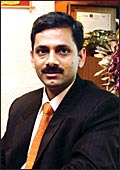 |
RANK
8
Bank king: K.V. Kamath, Managing
Director & CEO |
Last
fortnight a top-level reshuffle of portfolios took place at ICICI
Bank. Chanda Kochhar, the 44-year-old Deputy Managing Director,
is now at the helm of the bank's burgeoning international operations
as well as corporate banking. V.Vaidyanathan, 38, takes over the
retail banking portfolio from Kochhar, after being elevated to
Executive Director. Kochhar in turn fills the void created by
the exit of Lalita Gupte, Joint Managing Director, who headed
the international portfolio, and who retired at the end of October.
Gupte's deputy, 40-year-old Bhargav Daspupta, has been promoted
as Executive Director at the life insurance subsidiary, ICICI
Prudential. With Kalpana Morparia, Joint Managing Director, slated
to retire in a few months, the buzz is that Shikha Sharma, CEO,
ICICI Prudential, will find a place in the bank's top management
(although this could not be confirmed at the time of writing).
 |
| Retail business: In full
swing |
Such a change-around at the top would invite
considerable attention in most Indian corporations, but at ICICI
Bank's it's just another day at the office. That's possible because,
as Kundapur Vaman Kamath, Managing Director & CEO, points
out: "We have a great depth of talent; and we have layers
of talent. Ever since the mid-eighties we have been consciously
creating a talent pool, a pool that's multi-skilled. And that's
paying rich dividends today." Kamath, who started his career
way back in 1971 at ICICI, is also busy grooming the next line
of leadership. "The options are many, and I still have some
time," quips the 58-year-old CEO.
| NUMBERS THAT MATTER |
BT500 market cap: Rs 50,726.18
crore
Headcount: 25,384
Number of shareholders: 5.1 lakh
Number of directors: 17 (including 5 working directors)
Total customer base: 17 million retail customers
Source: ICICI Bank
Figures as on March 31, 2006, except for BT500 market cap |
If ICICI Bank is the only financial institution
to figure in the top 10 of the BT 500-housing finance colossus
HDFC stands at #12, and HDFC Bank comes in at #17-its people constitute
one vital ingredient of the success recipe. The two other constituents
of the blueprint that was relied on to transform the once heavily-reliant-on-corporate
lending behemoth into a nimbler, market-savvy and technology-enabled
entity are capital and a diversified basket of products. Six years
ago, Kamath (who was himself groomed by ICICI Chairman N. Vaghul)
initiated the unique merger of a large development financial institution
(DFI) with its fledgling banking subsidiary ICICI Bank. Today,
Kamath has not only transformed the ICICI Group from an unexciting
corporate lender into a universal bank offering multiple retail
products, but can also take credit for pioneering the retail finance
boom in India. The Rs 2,50,000 crore ICICI Group is known as a
one stop shop for a whole gamut of financial services. Ensconced
in his 10th floor office in the swank ICICI Bank headquarters
in the Bandra Kurla complex in suburban Mumbai, Kamath is looking
ahead, nurturing his five engines of growth: Retail, rural, international,
traditional corporate banking and lending to small & medium
enterprises (SMEs). "Over the next 3-5 years, our overall
credit book will probably be 50 per cent of urban consumer credit,
18 per cent agricultural and rural credit and 40 per cent will
be corporate credit, both domestic and international," discloses
Morparia.
 |
With over
17 million customers in the bag, ICICI has been strategically
cross-selling its group products such as insurance and mutual
funds
Chanda Kochhar
Deputy Managing Director |
Retail hasn't tailed off
The first growth platform kicked off a decade
ago, in a bid to wean the bank away from project lending, was
retail finance. ICICI Bank today boasts a retail portfolio of
Rs 1,00,000 crore-easily the largest amongst Indian banks-which
is almost 70 per cent of the bank's advances. Home and car loans
constitute 80 per cent of that figure. And it isn't as if the
new opportunities like rural and international are being explored
because retail growth is in danger of getting saturated. "It
still hasn't tailed off, and is in fact growing robustly at 30-35
per cent," says Kamath, who did an eight-year stint in the
Asian Development Bank before he returned to ICICI in 1996. Kochhar,
who has nurtured the retail portfolio for the past five years,
and who incidentally Kamath handpicked during campus recruitment,
is today reaping the benefits of economies of scale. Non-performing
assets (NPAs) are less than 1 per cent and, with over 17 million
customers in the bag, ICICI has been strategically cross-selling
its group products, too (like insurance and mutual funds. "Today,
20 per cent of the retail business comes from cross-selling,"
says Kochhar. New retail head Vaidyanathan feels credit cards
and personal loans are the two high-growth segments. "There
is a scope for 100 million credit cards in the country. We have
today just 20 million credit cards," says Vaidyanathan, who
played a key role in building ICICI Bank's credit card portfolio
of over 5 million.
 |
 |
| The talent pool at ICICI Bank
is large, and multi-skilled. V. Vaidyanathan
(left), 38, has been promoted as Executive Director
(Retail). Bhargav Dasgupta,
40, has been promoted as Executive Director at ICICI Prudential
Life Insurance. |
Then there's the rural thrust, currently contributing
6 per cent to the balance sheet, but the target is to increase
its contribution to take that figure up to 25 per cent. Kamath
terms it "the biggest challenge. Execution is going to be
a big, big task." Nachiket Mor, Deputy Managing Director,
who is spearheading the rural initiative, is busy scaling up the
hybrid channel architecture, a la an FMCG model, in rural markets.
The unique franchisee model is already bringing big bucks for
the bank. That's reflected in the portfolio of Rs 16,500 crore
in March 2006 which almost trebled in three years with the customer
base rising from 20,000 to 3.2 million. No White Spaces, as the
rural strategy is called, envisages having a kiosk or a franchisee
at every 10 km in the rural heartland. "We plan to cover
450 districts by 2008," says Mor, who holds a PhD in financial
economics. Also on the anvil are high-density crop branches in
places like Western Maharashtra, Coastal Andhra, Central Tamil
Nadu and South Gujarat.
If Indian companies are eyeing international
markets and at the same time foraying into under-penetrated rural
India, ICICi Bank is a great example of such an entity, although
it's target is more the global Indian rather than every global
consumer. Started in 2002, the international business model revolves
largely around Internet banking supported by partnerships with
local banks. Canada and the UK are two markets being targeted
as they have large non-resident Indian populations. Yet, as Kamath
points out, 70 per cent of customers (corporate and individuals)
are non-Indian. There's also the burgeoning remittances into India
market, which is growing at 25 per cent. And another focus area
on the international business front is participation in the financing
of cross-border mergers and acquisitions. "We want to leverage
our corporate relationships in the global market," says Joint
Managing Director Morparia.
 |
Mor is leading
the bank's rural strategy called 'no white spaces', which
envisages having a kiosk or a franchisee at every 10 km
Nachiket Mor
Deputy Managing Director |
It's a business model that's playing out splendidly,
which is reflected in the growth in bottom line in the recently
concluded second quarter, with net profits growing by 22 per cent
over the previous three months. On various other parameters like
quality of assets and capital adequacy, the first Indian bank
to be listed on the New York Stock Exchange is on a good footing
(although spreads are lower than the competition). Kamath doesn't
foresee calamity in the short term-the risk of an economic slowdown
is "muted," and that of an asset price bubble is being
closely monitored. Yet, ICICI bank enjoys a lower price to earning
multiple (P/E) than an HDFC Bank or a UTI Bank (see Dalal Street
Has Its Preferences). Manish Karwa, Equity Analyst at Motilal
Oswal Securities, reasons that "HDFC bank is growing faster
than the ICICI Bank." Kamath, for his part, refuses to get
drawn into comparisons, and prefers to see the bigger picture.
"Today, the top five Indian banks put together are smaller
than the fifth largest Chinese bank. That's the kind of challenge
we have...Today, any bank with a capital and net worth of less
than $2 billion in a country of the size of India has little significance."
In terms of market cap of Rs 50,726 crore, there's no other bank
in the banking space with that kind of market cap, which puts
ICICI Bank in a league of its own.
|










